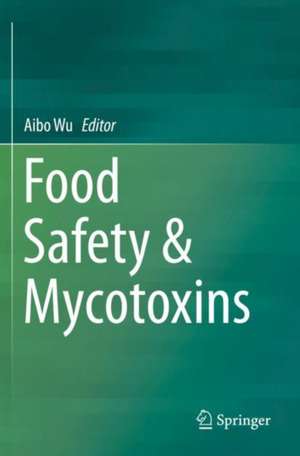Food Safety & Mycotoxins
Editat de Aibo Wuen Limba Engleză Paperback – 20 noi 2020
Mycotoxins are increasingly attracting attention at thegovernmental, public and academic level worldwide, due to more frequent and serious contaminations of food and feedstuffs, which pose a serious threat to human health and animal production.
This book reviews the latest research on mycotoxins that directly concern food safety, and especially focuses on detection technologies, risk assessment and control strategiescurrently being used in China. Gathering contributions from over 20 respected researchers, the book will benefit graduatestudents, researchers and management groups from various disciplines, including food science and technology, analytical chemistry, plant pathology, public health, etc.
| Toate formatele și edițiile | Preț | Express |
|---|---|---|
| Paperback (1) | 774.64 lei 38-44 zile | |
| Springer Nature Singapore – 20 noi 2020 | 774.64 lei 38-44 zile | |
| Hardback (1) | 929.05 lei 6-8 săpt. | |
| Springer Nature Singapore – 20 noi 2019 | 929.05 lei 6-8 săpt. |
Preț: 774.64 lei
Preț vechi: 1019.26 lei
-24% Nou
Puncte Express: 1162
Preț estimativ în valută:
148.29€ • 152.51$ • 123.03£
148.29€ • 152.51$ • 123.03£
Carte tipărită la comandă
Livrare economică 14-20 februarie
Preluare comenzi: 021 569.72.76
Specificații
ISBN-13: 9789813290402
ISBN-10: 9813290404
Pagini: 169
Ilustrații: X, 169 p. 60 illus., 33 illus. in color.
Dimensiuni: 155 x 235 mm
Ediția:1st ed. 2019
Editura: Springer Nature Singapore
Colecția Springer
Locul publicării:Singapore, Singapore
ISBN-10: 9813290404
Pagini: 169
Ilustrații: X, 169 p. 60 illus., 33 illus. in color.
Dimensiuni: 155 x 235 mm
Ediția:1st ed. 2019
Editura: Springer Nature Singapore
Colecția Springer
Locul publicării:Singapore, Singapore
Cuprins
Part 1. Detection.- Chapter 1. Chromogenic platform-based lateral flow immunoassay.- Chapter 2. Sample preparation and chromatographic analysis.- Part 2. Risk assessment.- Chapter 3. Toxicity evaluation using animal and cell models.- Chapter 4. Risk profiling of co-occurring contamination.- Chapter 5. Metabolism of Mycotoxins and the Potential Biomarkers for Risk Assessment.- Part 3. Control.- Chapter 6. Origin of mycotoxin-producing fungal and bacteria species.- Chapter 7. Enzymes for degradation of mycotoxins.- Chapter 8. Confrontation of microbes with mycotoxin-producing strains.- Chapter 9. Chemical and physical treatments for reducing mycotoxin.- Part 4. Summary and prospective.- Chapter 10. Summary and prospective.
Notă biografică
Dr. Aibo Wu is currently working as a Professor and Principal Investigator at Shanghai Institute of Nutrition and Health (SINH), Shanghai Institutes for Biological Sciences, Chinese Academy of Sciences, Shanghai, China. (2015-present). Previously held positions: (2011-2015) Professor and Associate Professor, Institute for Agri-food Standards and Testing Technology, Shanghai Academy of Agricultural Sciences, Shanghai, China. (2005-2010) Associate Professor and Assistant Professor at the School of Life Science and Biotechnology, Shanghai Jiao Tong University, Shanghai, China. (2009-2011, one month per year), Visiting Scientist at Ghent University, UniversitéCatholique de Louvain, Belgium. (2005-2007).
Dr. Wu completed his PhD (1999-2004) in Molecular Plant Pathology at Huazhong Agricultural University, Wuhan, China. Since 1999, he has exclusively focused on risk assessment and control of Fusarium mycotoxin contaminations in foods. In the past five years, hehas published 26 peer-reviewed full-text articles in internationally respected journals, e.g. Analytical Chemistry, Journal of Agricultural and Food Chemistry,and Toxins. He was selected as a Distinguished Young Scientist by the Chinese Institute of Food Science and Technology in 2017.
Moreover, Dr. Wu serves on the editorial board of the journal Food Control; on the Toxin Committee of the Chinese Society for Microbiology, Chinese Society of Microbiology; and is a member of the Food Hygiene, Chinese Preventive Medicine Association. His research areas include (1) risk assessment on co-occurring Fusarium mycotoxin contaminants originating from mycotoxin-producing fungal isolates in foods; (2) elucidation of contamination patterns, regulatory and control mechanisms of mycotoxin production in foods; and (3) establishment and validation of chromatographic approaches (LC-MS/MS) and immunological rapid assays for multi-component mycotoxins in a variety offood matrices.
Textul de pe ultima copertă
Mycotoxins are increasingly attracting attention at thegovernmental, public and academic level worldwide, due to more frequent and serious contaminations of food and feedstuffs, which pose a serious threat to human health and animal production.
This book reviews the latest research on mycotoxins that directly concern food safety, and especially focuses on detection technologies, risk assessment and control strategiescurrently being used in China. Gathering contributions from over 20 respected researchers, the book will benefit graduatestudents, researchers and management groups from various disciplines, including food science and technology, analytical chemistry, plant pathology, public health, etc.
Caracteristici
Introduces mycotoxins that are relevant to food safety Offers specific and unique information on detection, risk assessment and control approaches in China Provides readers with a fundamental grasp of mycotoxin research
